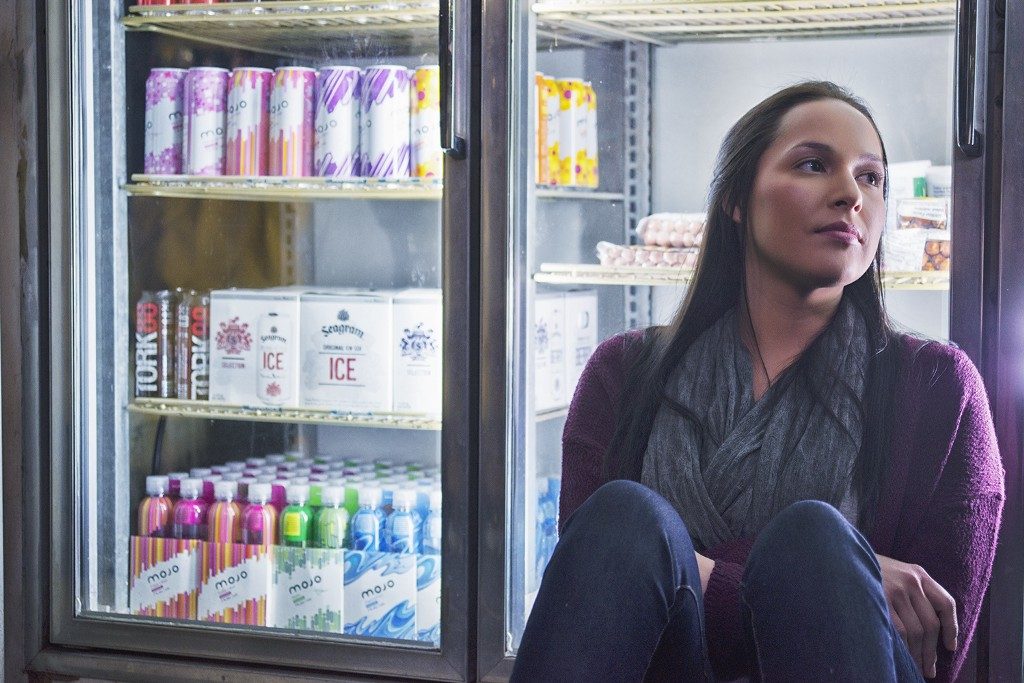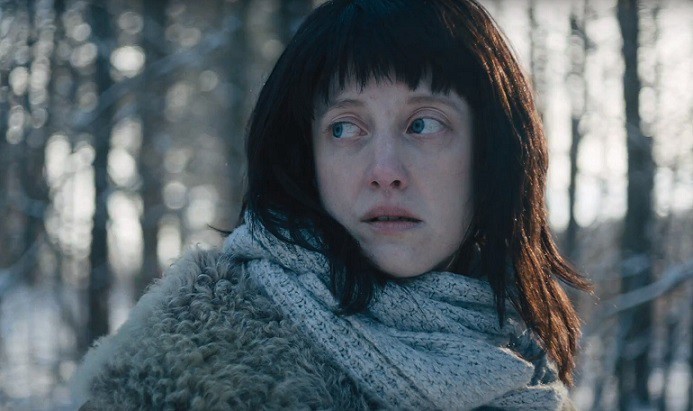Two Canadian First Nation women — a director from the
Kanesatake Mohawk tribe and an actress from the Uashat mak Mani-Utenam community — teamed up recently to make one of the first-ever female-directed, indigenous films — and it’s a genre flick with a kick-ass female lead.
“Le Dep,” director Sonia Bonspille Boileau’s first
feature, is set almost completely in a convenience store in a small First
Nations community in rural Québec. The claustrophobic setting was initially a consequence of the film’s tiny budget, but ultimately worked unexpectedly well, helping to
build tension in the psychological thriller.
Lydia (Eve Ringuette), a young Innu woman, is
preparing to close up her father’s shop one evening, only to be held up at
gunpoint by a masked robber. The set-up gradually evolves into a pointed social
critique, as “Le Dep” explores the deep wounds of one indigenous Canadian community.
These communities have traditionally been stereotyped
or just plain ignored in the arts and media, Lydia, however, defies traditional representations of non-white women as victims,
seductresses or wise old women. Her story, a mash-up of the director’s and the
actress’s personal experiences, emerges as a rare example of Aboriginal women
telling their own stories.
Bonspille Boileau’s film is proof that a crucial part of
re-establishing identities left in shambles after the cultural genocide of the
Canadian Residential Schools — a program that removed 150,000 indigenous children from their homes and placed them in boarding schools to erase their First Nation identities — is re-gaining control of images of themselves. In
Canada, where most of the films are state-funded, allocating funds specifically
to projects by Aboriginal filmmakers supports projects that might otherwise never get the chance to be made.
“Le Dep” had its world premiere at the 50th Karlovy Vary International Film Festival. Bonspille Boileau spoke to Women and Hollywood about the new state funds for First Nations filmmaking, the urgent need for more and fuller indigenous representation in film, and why she set all of the film’s action in a convenience store and how she worked to make that lack of movement from getting dull.
Women and Hollywood: Examining social issues within genre
film doesn’t seem like the typical combination.
Sonia Bonspille Boileau: No! But it actually all comes from
the fact that it’s a one-location film. I don’t think it would have the same
vibe to it if it [were] spread out. Anyway, considering the maximum amount of
money our budget was allowed to have in the Telefilm micro-budget program, I
couldn’t really have a story with aliens and explosions and car chases. So I
decided to remove all the other locations and do it all in a convenience store,
except for one flashback. And with one location, there has to be a lot of suspense;
otherwise, it would be boring. In the end, it was a combination of different
elements, like the direction the DP took, that ended up turning it into a genre
film.
W&H: What is it like for a first-time filmmaker in
Canada?
SBB: Before the micro-budget program, it was extremely
difficult to make a first feature. Canada’s film industry is entirely supported
by Telefilm, and you have to get your feet in the wheel, which can be a really
hard process. I think it was even harder for — I don’t know, maybe I’m just being
a feminist — but I think it’s harder for women still. It’s a very
male-driven industry.
W&H: How about Aboriginal filmmakers? Is there funding
aimed at them specifically?
SBB: There is a funding program aimed specifically at them,
but it is very new. The micro-budget program is open to anyone, and that is
only in its third or fourth year. They added an Aboriginal
component only last year. It certainly helped. I’m not sure I would have made the film in
another context.
W&H: How much does the film reflect your own life as a
member of the First Nations community?
SBB: It’s always best to write about what you know. I based
all my characters on people I know, that are close to me. So I decided on a
convenience store in a First Nations community — there, everyone knows everyone.
You’re in a store, but then you deal with all sorts of things and all sorts of
issues and you end up knowing everyone’s life. I combined elements from my and
Eve’s community. There are people in my family who faced the situation that [Lydia] goes through. I wanted to tell a
story that would resonate with everyone, whether they’re Aboriginal or not, but
with an undertone or context that was Aboriginal.
W&H: What is the situation with the Innu communities in
Québec today like?
SBB: They have their struggles, for sure. But I think things
are getting better. Eve is Innu, and they
always had a very strong bond with the French-Canadian [side], with the Québec side. The Mohawk, where I’m from, don’t speak French; they’re mostly
anglophone. They don’t really bond or mesh with the [mainstream] population. They have
different issues that result from generations and generations of Residentials.
W&H: How present are the consequences of the Residential
Schools still?
SBB: Well, their mission was to “take the Indian out of the
child.” So basically, to make them Canadian, North American, white people, even by
means of physical and emotional abuse. There was even sexual abuse in some
schools. Being a Native American and an “Indian” was bad. Because these
children no longer had parents, being taken from their communities when they
were four, they didn’t know their tradition, culture or language, and they
didn’t have any parenting skills, [and so were] unable to raise their own families. They
often turned to alcohol and drugs, which created cycles of violence and
alcoholism. Our generation is the aftermath of that. My grandfather was in a
residential school, and he was taught not to speak Mohawk, so my mother doesn’t
speak it — a lot of people don’t. I didn’t grow up hearing it, but as an adult,
I’m trying to re-learn my language. In the Innu community featured in the film, the
language has always been a bit stronger. We are restoring pride in who we are.
There is a sense of responsibility to know tradition, especially in the younger
generation.
W&H: So creating your own images of yourselves in terms
of media representations is crucial.
SBB: Yes, and that too has come a long way in recent years.
Most of the First Nations have more of an oral tradition. In the arts and media
context today, that can be a bit hard to maintain, because we are more focused
on film and visual art. Up until recent years, film was much more focused on
the documentary side [among First Nations filmmakers]. Just like many documentary filmmakers, we saw the camera
as an opportunity to right injustices. A lot of filmmakers took the camera to
show the world that something [wrong] is happening and that it is unfair. Only in
recent years has there been an interest in drama, in fiction, in telling
stories. In the last five — not even ten — years, there’s actually been an interest
from the outside world for indigenous content. The first few times when I went
to indigenous film festivals, there was just a bunch of First Nations people.
Which is great. It is encouraging our films. But there wasn’t a non-indigenous
audience. And now, there definitely is. There’s this willingness to understand,
connect, reconcile. So, it’s growing. It’s definitely growing.
W&H: But Lydia is still a rare example of an Aboriginal
protagonist (and heroine) on film.
SBB: Definitely. There’s not enough heroines in films in
general. When watching Canadian films, I’m always asking myself where the women
are. And in another film, Eve was not the lead actress. She played an
important part, but she wasn’t carrying the story — she was its victim. When I
was writing “Le Dep,” I acknowledged that she was a victim of a crime, but
I wanted her in control, to keep control, to be a heroine. It
was really important for me, especially because in Canada, there’s a huge
problem with missing and murdered Aboriginal women. We account for a quarter of the
murder victims, but we only represent 4% of the population. So obviously,
there’s something wrong there.
For the longest time in film, indigenous women
were stereotypes. You were either a sleazy temptress that was supposed to leave
with the white man, an elder, or a drunk junkie. There was no other dimension,
no emotions. By changing the way we view and treat indigenous female characters
that are in media, on television, I’m hoping that the younger generation will
have women to look up to and have better self-esteem. Maybe it will help change
the statistics on missing and murdered Aboriginal women, by creating a stronger
way of seeing ourselves. Hopefully.
W&H: What are the consequences of seeing the same images
over and over again?
SBB: You grow up thinking you are not worth more than what
you are seeing. Film is supposed to be a reflection of society. If what you are
seeing as a reflection of your own society is just one-dimensional or a very weak
person, and you never see past that, then it is hard. You may not realize it,
but subconsciously, that is what you think you are. That is what you think you are
worth. So that is definitely one thing that I want to break.







